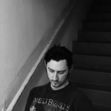Barret Baumgart's Blog: Dumpster Fires
November 18, 2025
The Los Angeles Times Published My Opinion Piece
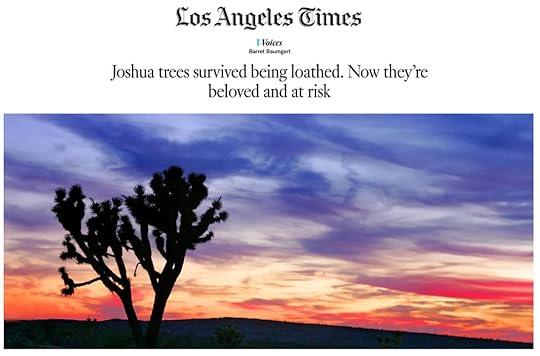
I swear this is the last time I will post about my new book YUCK!!
But this one feels warranted. The Los Angeles Times today published an opinion essay that I somehow snuck through the slush pile. Hundreds of comments and dozens of complaints sent previously to LA Times in protest of Gustavo Arellano’s plagiarism of my El Aliso reporting were, apparently, not enough to put me on a blacklist permanently.
Read it: https://www.latimes.com/opinion/story/2025-11-18/joshua-trees-climate-change-extinction
The article is brief and not exactly brand-new info to any diligent Dumpster diver but it’s quick and punchy, worthy of sharing with your uncle, or co-worker, or teacher, or ex-boyfriend, or anyone who might enjoy learning something surprising about the world they inhabit.
It’s also a powerful bit of validation for a strange small book that was supposed to die alone unread in an underwear drawer.
It’s also a little hopeful.
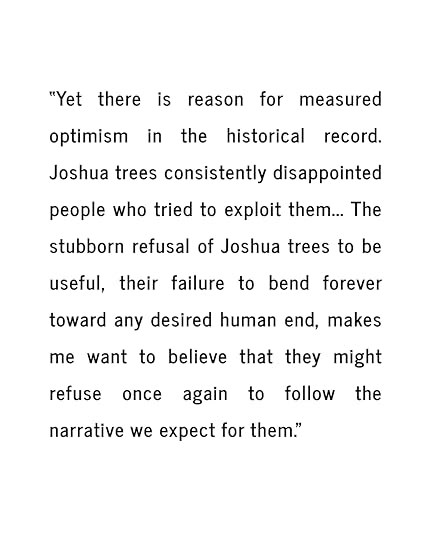
I love that it is the stubborn weirdness, the confounding grotesquerie of the Joshua tree itself that furnishes—maybe—the source of its hope.
It’s almost poetic, possibly enough to weave a weird book around…
Other non-news: I’ve been sitting on ton of writing and not hurling it here. Not yet. But rest assured, deep down beneath the Amazon Prime boxes, the Hello Fresh boxes, and the Chewy boxes, a fertile bed of fetid embers burns.
Dumpster Fires is a beacon of light in a world of trash and sorrow. To receive new posts and support my work, consider becoming a free or paid subscriber.
October 27, 2025
The "Infernal" "Grotesque" "Demoniacal" Joshua Tree
Did you know that Joshua Tree National Park was founded on Halloween Day, 1994? It’s almost as if federal government had some inkling of the vast hate once heaped upon the lowly, humble, “demoniacal” Joshua Tree.
The strange saga of Joshua Tree antipathy was largely forgotten until, well, I dug it up and turned it into a new book—YUCK: The Birth & Death of the Weird & Wondrous Joshua Tree, Yucca brevifolia.
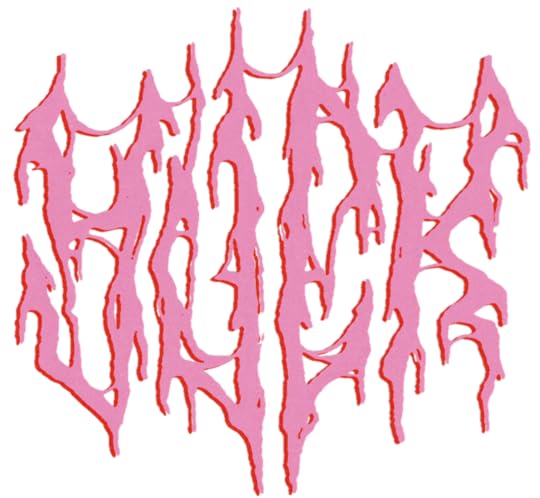
For Halloween, I thought I’d toss out a couple of the more merciless and inspired attacks I came across in my research. These choice bits all come from the astonishing and largely overlooked California Desert Trails, written by Joseph Smeaton Chase in 1919.
“It is a weird menacing object more like some conception of Poe’s or Doré’s than any work of wholesome Mother Nature. One can scarcely find a term of ugliness that is not apt for this plant… A landscape filled with Joshua trees has a nightmare effect even in broad daylight: at the witching hour it can be almost infernal.”
“Wild-looking shrubs leaned out overhead and stared down at us with startled air. Strangest of these were the so-called Joshua trees… Nothing in the vegetable world is more unprepossessing than this scarecrow, all knees and elbows, with handfuls and mouthfuls of daggers for leaves.”
“My friendly trees ceased at once at the foot of the canyon, leaving only the Joshuas, which always seem to have been arrested in the midst of some uncouth antics, brandishing daggers like a juggler.”
Please, will somebody be a Joshua Tree for Halloween already?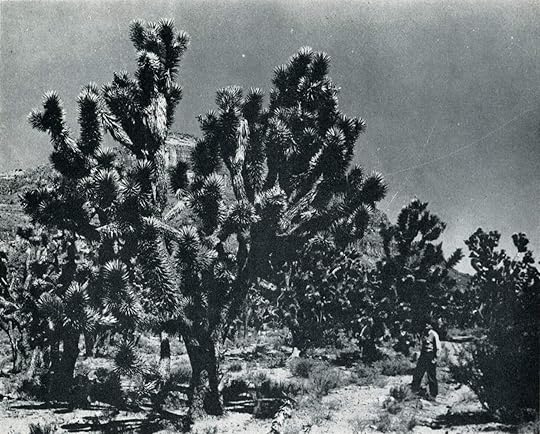
Like the Sphinx, there is no answer to its riddle. It is in the fascination of the unknowable, in the challenge of some old unbroken secret, that the charm of the desert consists. And the charm is undying, for the secret is: Secrecy.” —Joseph Smeaton Chase, California Desert Trails, 1919
For more on the mysterious forgotten master of American nature writing, JS Chase, see my previous post, “Cosmic Bard of the California Badlands.”
In other news, you can catch myself and writer, photographer, and adventurer —founder of the Forgotten Lands Project and author of the important and powerful new book, The Enduring Wild: A Journey into California’s Public Lands—live in conversation in Los Angeles at the Last Bookstore on ✦ Wednesday, December 17th ✦
We’ll be speaking with journalist Dana Covit about forgotten lands, forgotten histories, and the importance of preserving both.
And if you haven’t checked out YUCK yet, published last spring by Wandering Aengus Press, you can get a feel for it in the above Halloween-themed video. You can also purchase it in paperback or audio here.
For now, be very afraid…
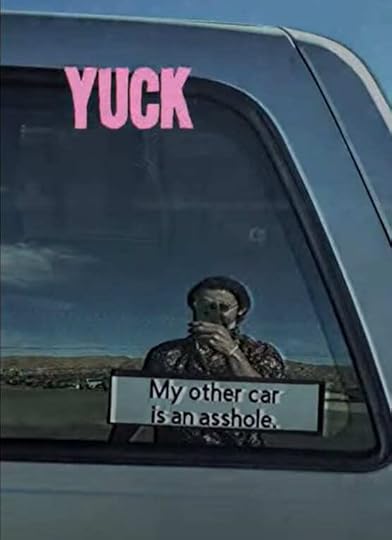
Dumpster Fires is a beacon of light in a world of trash and sorrow. To receive new posts and support my work, consider becoming a free or paid subscriber.
September 27, 2025
The Most Sexually Frustrated Cat on Earth
For years I’ve wanted to say something about P-22, formerly the world’s most famous mountain lion (RIP-22).
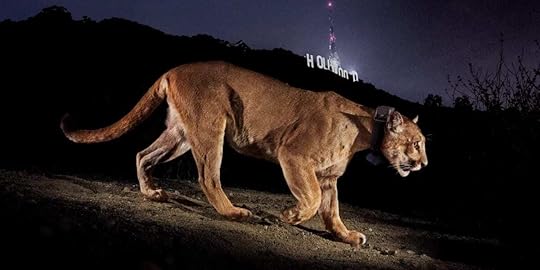 Real Photo. Steve Winter / NPS.gov
Real Photo. Steve Winter / NPS.govAnd, well, I finally got around to it—albeit in the form of a deranged 3 minute Instagram Reel, created largely in the hopes of improving my numbers on social media so that I might eventually attract a literary agent to sell my next book, an agent search now being a regrettable necessity as I foolishly fired my previous representation some years ago after he proved unable to seize the moment, i.e. that week Kim Kardashian started Tweeting about her discovery of the nuclear meltdown site hiding behind her mansion in Hidden Hills, a site whose radioactive fallout the Woolsey Fire was then in the process, possibly, of seeding all across Southern California.

Anyways, Santa Susana is safe now for people and mountain lions—if you would believe the glossy brochures produced by the Boeing Corporation.
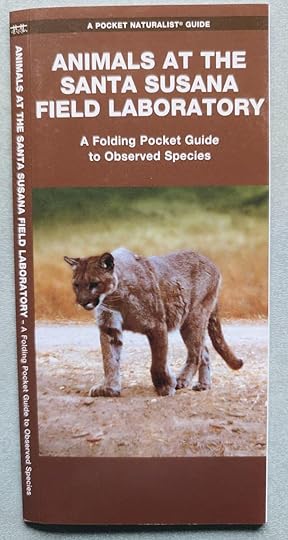
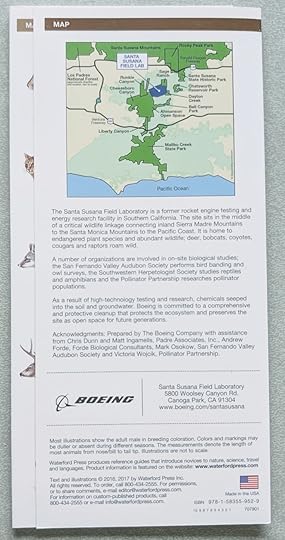
Of course, P-22 is hardly hidden history. I’m not sharing anything new. And yet, as my Reel makes clear, and perhaps the below paragraph… I’m constantly astonished how few people—even Angelenos—know the improbable true story of the Mad King of Griffith Park.
One of my favorite experiences bartending at Angel City Brewery has always been educating people about mountain lion habitat in Southern California… “Give me a P-22, people will say.” “P-22?” “Yeah,” they’ll say, “the mountain lion one.” I’ll pour it and come back, a twinkle in my eye, voice a soft purr. “Do you know who P-22 is?” They’ll say, “Uh. Who? It’s like some kind of hop,” they declare, an educated guess. And say, “No, bro. It’s not a hop. P-22 is the world’s most famous mountain lion. He lives alone on an island.” And when they look at me like I’m crazy, I’ll say: “He’s the most sexually frustrated cat on earth.” And when they’re starting to look afraid, I’ll say: “He lives alone on an island at the center of Los Angeles, and he’s never had sex.” And when they’re trying to rapidly complete the transaction and move away as quickly as possible, I say: “He crossed like six freeways. Most mountain lions get obliterated by a semi-truck trying to cross like one. But he’s tough. He crossed like six. All to eventually maroon himself friendless and sexless at the center of Los Angeles. Most thought he’d move on in search of a mate, but instead he stayed.” “An island?” they’ll say. “Yes,” I say, “Griffith Park, a figurative island surrounded by the wasteland of like 50 freeways, the largest urban-wilderness preserve in the United States at 4,300 acres.” Most people, even if they’re from LA, still haven’t heard of P-22. “Is this, like, a myth?” they’ll say, and I say, “No, bro. It’s P-22. P stands for puma. He’s numbered and has a radio collar. There’s some scientist somewhere who can look on a computer and see where he’s chilling all the time. But he just stays on his island at the center of Los Angeles, not bothering anybody, never seeking a mate, just feasting on mule deer, jack rabbits, and recently, a chihuahua until...”
P-22 passed away near the end of his natural life cycle in 2022. Angel City Brewery began brewing the beer in honor of the boy in the Fall of 2018.
October 25, 2025, is P-22 Day in Los Angeles. To learn about events and help protect SoCal cougars go to SAVELACOUGARS.ORG.
Hiking in Griffith Park just isn’t the same anymore…
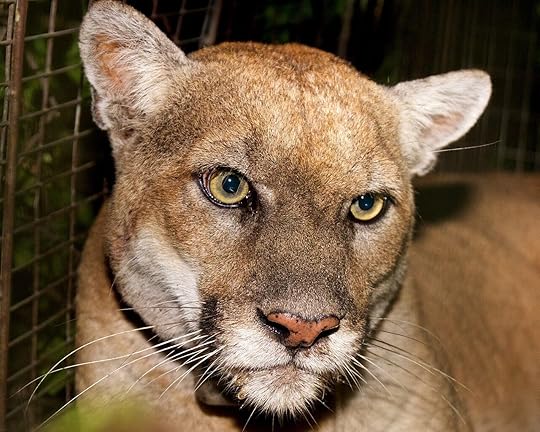 Puma No. 22
Puma No. 22Dumpster Fires is beacon of light in a world of trash and sorrow. To receive new posts and support my work, consider becoming a free or paid subscriber.
August 29, 2025
Albert Bierstadt Was Always Botox
Today the Department of Homeland Security, headed by the comely Kristi Noem, posted a picture of one of my favorite paintings.
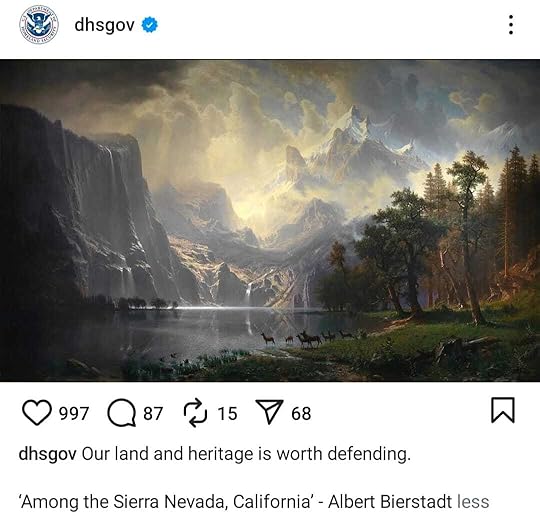
I suppose Kristi must imagine that a few months ‘among the Sierra Nevada’ is all the National Guard would need to restore ravaged and chaotic California to its former splendor. But Bierstadt, like Krisi, was mostly selling fiction. None of old Albert’s cosmetic creations ever made it to market without, first, a thick fat basecoat of Botox. And let’s be honest, the only thing that might beautify this great nation today is if the National Guard were carrying the trash that is the Trump family out of DC in those big industrial Glad Bags.
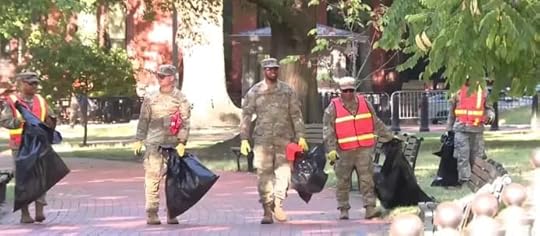 National Guard in DC on WednesdayFor your morose delectation, I have included my full comment on the Department of Homeland Security’s post below. Please enjoy.1
National Guard in DC on WednesdayFor your morose delectation, I have included my full comment on the Department of Homeland Security’s post below. Please enjoy.1
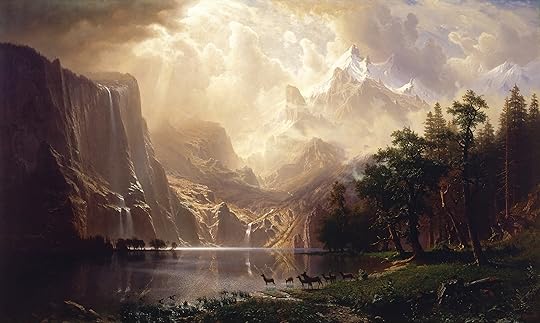
Dear Kristi, whereas previous works name specific sites like The Domes of the Yosemite, or Lander’s Peak, here Bierstadt leaves the locale of his Sierra Nevada, a mountain range eighty miles wide and five times longer, mysteriously vague. And yet even knowing it depicts no true mountain view, I suppose Bierstadt might easily be forgiven. If the landscape painter’s task is, as Ruskin insisted, to “direct people’s attention accurately to the beauty of God’s work in the material universe,” then the painting is unquestionably successful, for although the technicolor mountains, inflated to a height beyond hyperbole, certainly do not exist in California’s Sierra Nevada—as someone once employed by the US Forest Service building trails in the Sierra, I might know—one must assume, given theoretical physicists increasing insistence on an infinite number of possible worlds, that they do exist in some corner of ‘the material universe,’ even if that corner does not include the planet Earth. Not so much a composite as a work of fantastical art, Among the Sierra Nevada perhaps has value as a kind of proto surrealism, pointing the way toward the science fiction visions of, say, H.R. Giger or Zdzisław Beksiński, postwar painters of alien worlds and landscapes where bones, bodies, and machinery continually combine and entwine, expanding and building forever outward toward some inscrutable purpose one is happy never to fathom. And in fact, in Bierstadt’s Sierra, the snowy slopes rising above the emerald valley floor, receding and ascending over further terraces and balconies into increasingly swollen heights everywhere pierced with outlandish slanting spires, teetering pinnacles, and bony buttes do eventually begin to suggest, more so than any realistic mountain landscape, something gathering its limbs, struggling for birth as it strives to push its brittle bones through the pale tissue of some kind of pyramidal egg sack. Rays of gold project through a dome of swirling cloud, showering the scene in what Bierstadt must have intended as some kind of heavenly light, although the longer you stare at the painting the easier it is to imagine the blinding glare emanates from the descending eye of some kind of malevolent drone come to harvest another hatchling deformity from the smoldering hive. Disney illustrators working beside the Los Angeles River in their Burbank offices would later study such nightmare effects in eras before the advent of CGI. And yet I have a feeling that today, behind the fantasia, we might find nothing more than another Jurassic shipping crane stretching its limbs. Certainly, Bierstadt required the advent of some sort of similar implement as the gigantic ten by fifteen-foot canvas went trotting all over Europe, from Rome to London, Paris to Moscow, and Berlin’s Royal Academy where it won the Exhibition’s Gold Medal. At the very least, the painting reveals that by 1868 Alfred Bierstadt had stopped seeing what was actually there. Mark Twain himself had already admitted as much. In 1867, perhaps finally grasping that ‘intelligible something’ he found so maddening in Church’s Andes, he mocked Bierstadt’s Domes of the Yosemite, calling it “very beautiful, considerably more beautiful than the original.” Ambrose Bierce cut deeper, glimpsing beyond the theatrics something abominable and grotesque struggling for birth. “It is with grim satisfaction,” he mocked, “that we record the destruction by fire of Bierstadt’s celebrated picture of Yosemite Valley. The painting has been the prolific parent of ten thousand abominations.” An early mountaineer of California’s Sierra Nevada, Clarence King, likewise found Bierstadt’s mountains too lurid, flimsy, and finally just fake. He wrote in 1872 that “It’s all Bierstadt and Bierstadt and Bierstadt nowadays! What has he done but twist and skew and distort and discolor and belittle and be-pretty this whole doggonned country? Why, his mountains are too high and too slim; they’d blow over in one of our fall winds… He hasn’t what old Ruskin calls for.” On a deeper level, though, beyond the charge of infidelity, Bierstadt’s desperately exaggerated summits, the endless unfurling hulk of their unrealism, their too high and too slim peaks crowned with improbable protruding mountain horns—they do not lift a song of God’s glory or the Country’s inexhaustibility. “O beautiful for spacious skies… For purple mountains’ majesties…” In fact, by what Alan Watts might call The Law of Reversed Efforts, they whisper just the opposite. Even the deer at the foreground of the painting seem to hear it. They stand frozen beside a silver stream, ears pointing, listening as they peer alarmed, away from the light, toward something in the forest outside the painting’s frame. What do they hear? What might they see? It’s hard to say, but I believe it’s what Blakelock finally saw. A conviction that sunk to the depths of his marrow long before he touched California’s shores. Something visceral that urged him away from realism, and eventually, beginning in the 1880s, before he went insane, compelled him to utilize the color black more than any other painter in history. You can see it, too, albeit indirectly, in Bierstadt’s Sierra, which means saw, from the Spanish serra. The painting reveals unconsciously, precisely through all its striving heights, a dark underworld of doubt, a lurking suspicion, indeed the mounting dread and creeping terror that the palace of Nature may not be the benign and limitless monolith once pretended. And the voice outside the frame that whispers to the startled deer? It is just what we have most to fear. The voice is our own, the approach of Man, bearing the ravages of the axe and saw…
The above is an excerpt from my third book, which—somehow, yes—is about the 1959 nuclear meltdown at the Santa Susana Field Laboratory at the end of Los Angeles’s San Fernando Valley.
Soon I’ll post a longer excerpt from this insane section of the book that bridges the bits hinted at from my previous El Aliso post, connecting Bierstadt and the Hudson River School painters to the Los Angeles River and the trauma and genius of an even better artist, Ralph Albert Blakelock.
I’ll remind you: the headwaters of the Los Angeles River begin at and flow off of the irradiated, alien-looking hills of the Boeing-owned Santa Susana Field Laboratory…
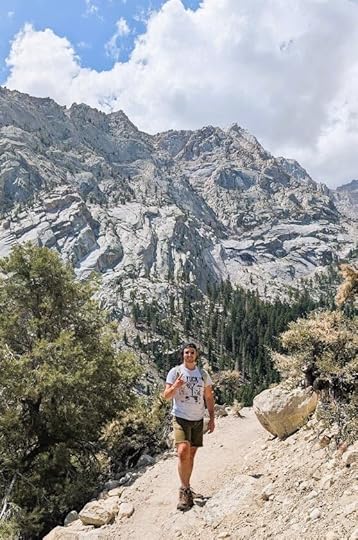 The author among the Sierra Nevada last month
The author among the Sierra Nevada last monthDumpster Fires is a beacon of light in a world of trash and sorrow. To receive new posts and support my work, consider becoming a free or paid subscriber.
1This post is a paid advertisement for Gustavo Arellano.
August 14, 2025
The LA Times Stole my Viral Reporting
On Monday, it came to my attention that one of the most prominent journalists in Southern California, Gustavo Arellano, lifted the contents of the viral Reel I shared with you and thousands of other people last week.
My El Aliso Instagram Reel, viewed 23,000 times, with a total watch time of 127 hours, 526 shares, 193 saves, and 59 comments, “broke” the story (earth-shaking news, I know!) that the historic plaque for this sacred, little-known, long-dead tree was missing. Beyond that, in a brief and pithy little package, it unpacked some serious virtually unknown history that stunned and delighted thousands of viewers with its combination of humor, heaviness, and meaningful informational content.
On Monday, I was shocked to see dozens of messages coming at me from friends and strangers alerting me to the fact that the LA Times, and its star ‘reporter’ Gustavo Arellano, had traveled to the exact same site and reproduced the same shots as my Reel in their own wildly popular video posted to Instagram, YouTube, and the LA Times website. Their video even drew attention to the strip club behind the plaque’s location, as I did at the start of my video (to humorous effect), and of course pointed out the tragic, unacceptable fact that the one forlorn, miniscule memento this once sacred tree has been allowed (the plaque) is now gone. Stolen.
#stolen
Gustavo Arellano denies knowing of the existence of my Reel. He told me when I reached out to him that he had no idea of its existence. He said he had arrived at the location by the same means I did, “reporting.” He also said, “I always cite sources.”
The LA Times has been expanding their reach and staying afloat through an increasing pivot to social media content creation under new billionaire ownership. It’s hard not to see Gustavo’s posting on the El Aliso just six days later, after my Reel had been seen tens of thousands of times, as mere coincidence. This was an opportunity for some great content to bolster the Lard King of The Los Angeles Times.
#coincidence
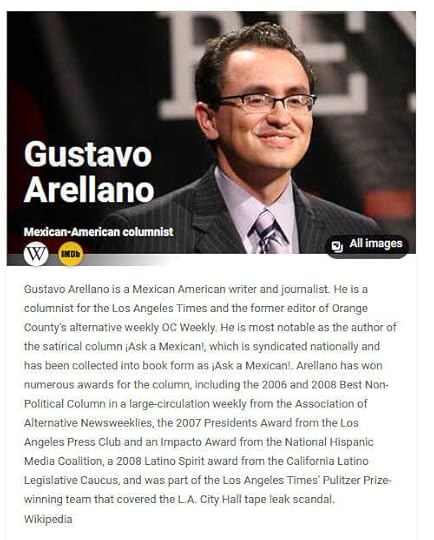
Of course, I don’t own the topic. It’s public knowledge. In some ways I’m flattered by this flagrant and obvious copy of my quality original content. This could have turned into a great opportunity.
Gustavo could have credited me in the first place, complimented the quality of my video, the writing that went into it, the time it took to produce, cut together, etc.
He also could have done none of that.
When approached, he could have said, “Man, what a coincidence!” He could have continued that line for some time, whether true or not. “What are the odds! Wow! I can’t believe! I’m so sorry! I had no idea! That’s so cool! You’re Reel is really great, man! Jeez. Again, what are the odds!?”
He could have acknowledged the extremely unlikely concurrence of our arrival at the same place to produce the same content—with him stumbling up a mere six days later. I would have accepted this, and bought him a beer, and we could have become friends. Perhaps this is still possible.
But his defensive tone and utter dismissal of my concerns felt immediately disingenuous, and I’m now persuaded it demonstrates a genuine lack of integrity. I have spoken to dozens of people on this matter, and as the unrelenting onslaught of critical comments posted on Instagram beneath his and the LA Times’s Reel shows, nobody is buying his “reporting” line.
The fact that the LA Times lifted and repackaged my work becomes even more preposterous when I ponder the fact that the publication has utterly ignored every pitch I’ve ever sent them, offered not one response, not a single sentence to the numerous requests for op-eds and articles I’ve sent, to say nothing of having ever reviewed or looked at my books which offer, possibly, serious and sustained value to our understanding of Los Angeles, Southern California, and the landscape and history of the West.
But sure, go ahead and allow one of your biggest reporters—one of the most visible media figures in Southern California—to lift the first piece of social media content I create that reaches a broad, general audience. Thanks a lot!
This is all pretty small potatoes, but it’s left a pretty bad taste in my mouth. I used to enjoy hearing Gustavo’s voice on the radio around SoCal. I’ve always appreciated his reporting and writing and sense of humor. But in this instance he has flopped, and people have taken notice.
Further, his trite take on the tree in the second half of his LA Times video represents a watered down, feel-good Disneyification of history that is very nearly offensive. His breezy, upbeat suggestion that El Aliso constitutes some universal symbol of resistance for all the oppressed of Los Angeles whitewashes that actual, grim reality at the root of this tree—a history of literal slavery in Los Angeles. To claim that El Aliso was a place of gathering for Spanish, Mexicans, and Native Americans is inaccurate and it cheapens and glosses over the history and is potentially insulting to the Native American community for whom this tree was literally the center of a world, a world that the Spanish, then Mexico, and later rapacious white landowners literally raped, enslaved, and erased. Such a claim, however, does fit his Gustavo’s blasé brand. But it does not fit the history.
And if there is anything I’ve learned this week, reviewing the history of the past few days, is that I should not be surprised if the LA Times refuses to publish me but happily steals from me.
But maybe I’m wrong. Perhaps it’s all coincidence! But I don’t believe so. If I am wrong, however, I will happily apologize and retract and buy Gustavo two beers!
If you want you can read a bit of the note I sent to the LA Times below, which speaks to the unlikelihood of the coincidence angle, the easiest thing for Gustavo to have countered with.
No doubt books are built out of other books. The world is an interconnected web of reference. We all steal and repurpose. But don’t steal from the little guy at Dumpster Fires. My two books rest upon a massive foundation of journalism and history, which I credit (at times in the end notes to excess). The LA Times should have credited my reporting—or at the very least waited more than 6 days, at which point my Reel would have burnt itself out and no one would have noticed their flagrant rip-off.
See the comments below the Gustavo/LA Times’s Reel if you want to wade into the muck and fun.
latimes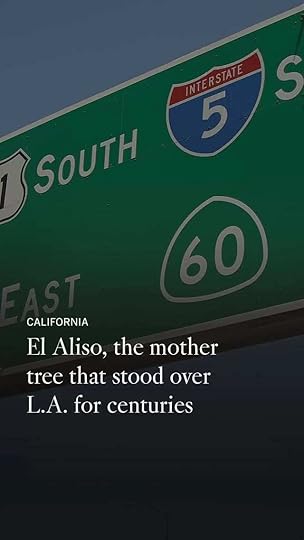 A post shared by @latimes
A post shared by @latimesSee the comments below the Reel I created in response to the LA Times plagiarism. The exchange with user sexington is illuminating.
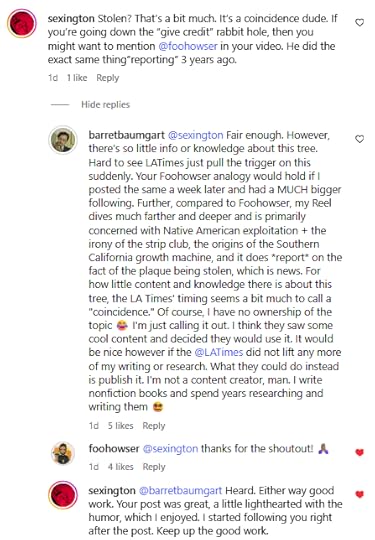
Below is an excerpt of the letter I sent to the LA Times. Coincidentally, this was the first time I ever heard back from them. “Thank you, Mr. Baumgart, for this detailed message which I'm forwarding to Gustavo and editor. I appreciate your thoughtful outreach.”
Is there anything you can do? Reach out to the LA Times HERE and let them know you are concerned about the quality and integrity of their reporting.
Of course, the timing could just be coincidence. However, this seems unlikely as the site in question, the subject of the Reel (El Aliso), is not widely known at all. To illustrate, on Instagram and across social media and the blogosphere there are virtually no Reels or popular posts of any substance on the subject of the El Aliso tree (it remains totally hidden history, overlooked). Over Instagram’s ~15 year existence there seems to be one Reel that was made three years ago, and it is very generic, superficial info that does not approach the informative deep dive that my Reel attempts. Given the lack of general information, public knowledge, and total absence of anything viral, creative, entertaining, etc. on social media regarding this El Aliso tree...
I'm left with the impression that Gustavo and the LA Times simply saw a very well-crafted, entertaining, informative viral Reel produced by a small, largely unknown writer/creator (Myself) and then proceeded to travel to the exact same location, reproduce the same shots, lift the topic of tree entirely, and report its pertinent information as though it were their own, particularly the fact of the stolen historical plaque.
Is there anything that can be done about this?
Dumpster Fires is a beacon of light in a world of trash and sorrow. To receive new posts and support my work, consider becoming a free or paid subscriber.
August 5, 2025
El Aliso Tree
Happy #NationalWhiteWineDay #winelover #winetasting Actually that was yesterday. For years I’ve wanted to create some “content” about this insane spot in downtown LA, a couple blocks a from where I work. And, well, I finally got my shit together and did it. Watch the video and weep.
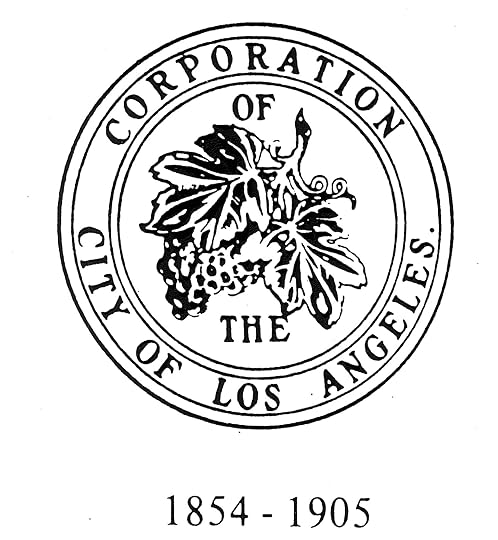 Los Angeles | “The City of Vines”
Los Angeles | “The City of Vines”The below is a brief written excerpt from a chunk of my next book, which is about the Santa Susana Field Laboratory’s 1959 nuclear meltdown in Los Angeles, an event which basically no one has ever heard of and that has perhaps killed thousands.
A chunk of this book follows the Los Angeles River and marinates in the beauty and misery that once existed alongside the famous El Aliso sycamore tree. In the book, I imagine my favorite painter, Ralph Albert Blakelock, camped at the base of the tree in the 1860s and sketching the LA River and El Aliso in his journal, sketches he later translated into one of his famous, haunting nocturnes (all of this, of course, before he went insane, was put in an asylum, and started painted American money while his family lived in poverty and his paintings fetched record-breaking sums at auctions, none of which he saw a dollar of; cheerful story).
I’ll eventually post this long section featuring Blakelock and the El Aliso tree. It connects to the crazy Terminal Island post I made a year ago.
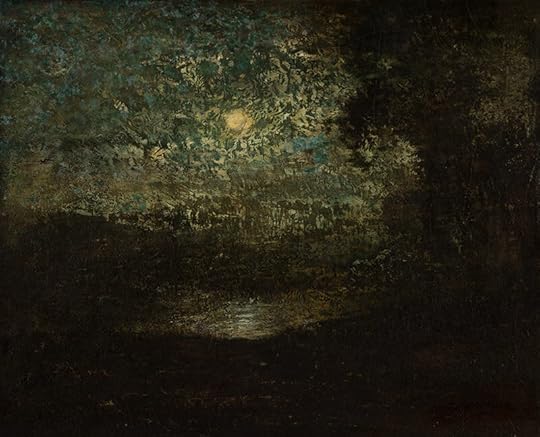 Blakelock, Moonlight, 1890
Blakelock, Moonlight, 1890Over the years I’ve tried to determine if more vines were planted or people buried in 1853, the year LA supposedly suffered more murders than any other municipality in the country. It’s hard to say for certain. What we do know is that most who visited Los at the time left either calling the place the City of Demons or the City of Vines. Not surprisingly, the city’s two competing faces actually constituted two sides of the same coin. Few understood the fact better than the Gabrielino Indians. As it turns out, progressive California’s very first law, passed by the new state congress on April 19, 1850, happened to be a perverse bit of legislation known as "The Act for the Government and Protection of Indians. The law ensured the protection of Native Americans by denying them the right to vote or testify in court, and it allowed for their immediate arrest should “any reasonable citizen” discover or suspect them of being unemployed or drunk. Horace Bell, an influential lawyer and publisher for whom Bell Creek is named—a small stream among the red rocks of the Santa Susana Mountains that constitutes the ultimate headwater of the Los Angeles River—recalled the city of Los Angeles’s steadfast and ingenious application of California’s inaugural law in an 1881 memoir: “By four o’clock on Sunday afternoon Los Angeles Street from Commercial to Nigger Alley, Aliso Street from Los Angeles to Alameda, and Nigger Alley, would be crowded with a mass of drunken Indians yelling and fighting. Men and women, boys and girls, tooth and toenail, sometimes, and frequently with knives, but always in a manner that would strike the beholder with awe and horror. About sundown the pompous marshal, with his Indian special deputies, who had been kept in jail all day to keep them sober, would drive and drag the herd to a big corral in the rear of Downey Block, where they would sleep away their intoxication, and in the morning they would be exposed for sale, as slaves for the week. Los Angeles has a slave mart as well as New Orleans and Constantinople, only the slave at Los Angeles was sold fifty-two times a year as long as he lived, which generally did not exceed one, two, or three years under the new dispensation. They would be sold for a week, and bought up by the vineyard men and others at prices ranging from one to three dollars, one-third of which was to be paid to the peon at the end of the week, which debt, due for well performed labor, would invariably be paid in ‘aguardiente,’”—a cheap distilled wine of 50% alcohol whose name meant ‘firewater,’ ardent being the Catalan word for flame—“and the Indian would be made happy until the following Monday morning, having passed through another Saturday night and Sunday’s saturnalia of debauchery and bestiality. Those thousands of honest useful people were absolutely destroyed in this way. Vineyards were of great profit in those days, and would be today, if we could recall the times as they were before the conquering Saxon came with his boasted perfection of laws, and his much-vaunted ‘advance civilization.’” Thus the city of Los Angeles, employing a system of exploitation truly befitting a City of Demons, protected Native Americans from “leading an immoral or profligate course of life”—as Section 20 of the Act for the Government and Protection of Indians stipulated—and as a cheerful spin-off of such legally sanctioned darkness, a sunny agricultural Eden began to take root at the bottom corner of the continent. Naturally, the city took for its first official seal not a grinning man with horns but a cluster of ripe grapes.
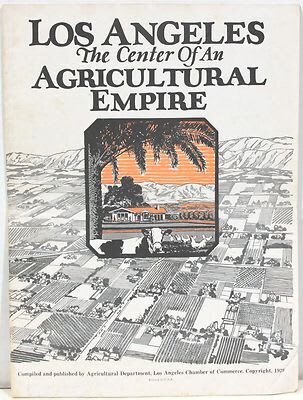
Dumpster Fires is a beacon of light in a world of trash and sorrow. To receive new posts and support my work, consider becoming a free or paid subscriber.
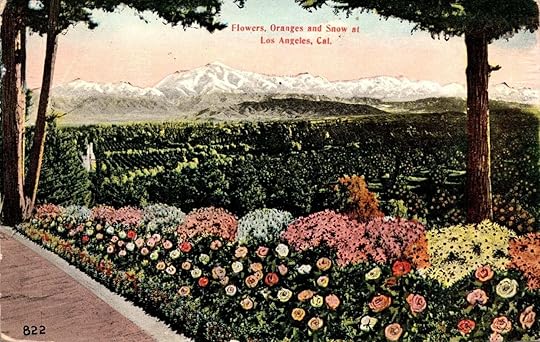
June 11, 2025
Cold and Lonely in Segovia
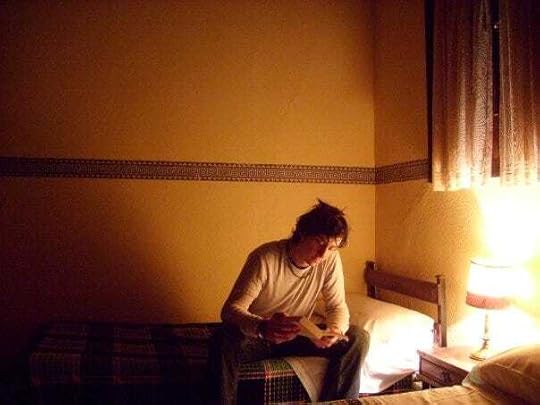 Cold and Lonely in Segovia
Cold and Lonely in SegoviaIn January 2008, I uploaded a photo album to Facebook called “My Friend the Continent Europe.” It was meant to advertise the permanent authenticity I imagined I had purchased for myself after spending a season traveling alone as a depressed twenty-year-old sleeping on strange men’s couches and eating only the lowest quality street food while it snowed.
In one photo I sat on the edge of a bed bending toward the dim lamplight of a rundown budget room I’d found not far off the cathedral square in Segovia, Spain. In my hands I held a copy of Melville’s Moby Dick. The room, a rare splurge, had, in hindsight, probably been purchased for this prideful excursion, a proto-selfie. Behold the lonely genius fast at work! Here he was caught in a rare light, a candid glimpse of the young auteur studying his craft.
It was a powerful portrait of devotion and discipline captured by a discount JBL digital camera set on timer mode atop the windowsill behind the second of the room’s two twin beds, neither of which the great writer could persuade a girl to share, not even the American study abroad students whose drunken garrulous cries in shrill Valley Girl accents echoed over the cobblestones and through the serpentine streets of the old Gothic quarters, poisoning the night as they carried out over the cathedral spires of every city like some loud public service announcement declaring the death of all mystery.
Years later this dreadful photo earned its first Like. It came from a beautiful young woman named Christina who, to my terror and delight, turned out to be stalking me. Upon this singular act of pity we established a profound and lasting bond.
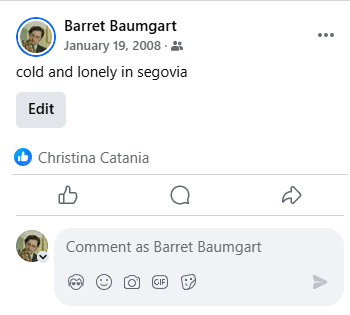 Real Wife Material
Real Wife MaterialIn any case, all this is to say I’ll be reading alone tomorrow in a rented room in Los Angeles and it will be broadcast live on Zoom.
Join me at 4pm Pacific for a live reading from YUCK followed by a Q&A. The event is hosted by my publisher Wandering Aengus Press, and I’ll be joined by fellow WAP author and poet Majda Gama.
Zoom link: https://us02web.zoom.us/j/88921757250...
Yuck,
B
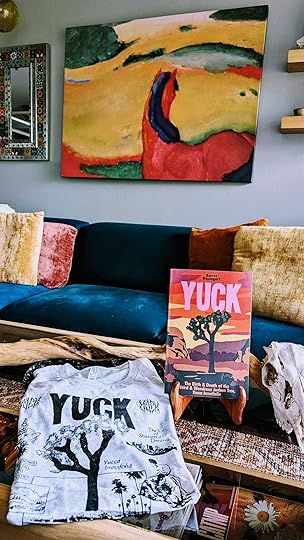
Dumpster Fires is a beacon of light in a world of trash and sorrow. Subscribe for new posts. Paid subscribers always make my day 💘
May 14, 2025
I Am Trash
⫸ Not sure precisely where this erupted from, but enjoy… Maybe I’ve inscribed too many copies of YUCK recently with that Philip K. Dick quote:
“Symbols of the divine show up in our world initially at the trash stratum.”
In second grade, my mom started giving me money for a school lunch. Before that she made it herself, a baloney sandwich on white bread. At school I’d eat the sandwich. After school I ate the plastic bag it was wrapped in. The woman whose house I went to daycare at drove a white minivan and hidden behind the rear wheel at the back of the garage I’d crouch and tear off tiny slivers from the main body of the bag, eating as many as I could manage before the fear of being found overwhelmed me. My behavior was a source of shame, a bitter compulsion that I couldn’t control and I hid it from other children, the daycare lady, and my mother. In my mind, the baloney sandwich was the heart of my sack lunch but it could never have performed its essential duty without a plastic bag to guarantee its safe passage from kitchen cutting board to school and stomach. Ignoring the bag was impossible. At the back of the garage each day, a new sandwich bag lay hopeless in my hand—just another sack consecrated to a weekday’s doldrums, destined for the dumpster, totally unfair. The bag could not help what it was… Like every human being, I suppose, I had to pay witness to suffering or invent it to keep life interesting. But unlike many, and to my detriment, I could not watch or pretend passively. So I took swift action, or I tried to—hours after lunch, finally alone in the daycare lady’s garage, I gagged down the day’s plastic as quickly as possible, a process seldom speedy since you had to carefully roll each sliver into a tight wad then swish it in your spit. Any other way and the scraps would lodge in your throat and make you choke, a setback that necessitated a further round of retching as your fingernails scraped over the cilia of your esophagus, searching for a loose end of the unraveled bag. By the end of it all, thoroughly sapped and sickened, I used to wonder if there wasn’t another way. But it would not have been enough to simply hoard the bags, to tape them together into a raincoat or some other bricolage. There were several years when my growth in inches exceeded San Diego, California’s annual rainfall amount. My mother, too, obsessed with cleanliness, would never have tolerated my collection. Of course I could have snuck around, jammed the bags in some larger plastic sack and prayed the baloney fumes never escaped my closet. But if they did, if my mother ever discovered and opened that grocery bag, she would have seen inside it not only a nest of bacterial infection but also perhaps her son, a boy whose insides too were tangled and improperly hoarded. Better that I went on my quiet way carefully incorporating the bags into my body and being. Rising from humble synthetic origins to join the organic cycle, the bags transcended their earthly destiny, and I was brave. My living body became itself a bag, the stomach lined with impassable scraps a vessel guaranteeing the life of the lonely souls that I had invented and freed across so many solipsistic afternoons of onlychildhood.
And it was generally after one of these plastic-fueled pity parties that, disconsolate and constipated, I turned to my mantras.
 Formative Memories
Formative MemoriesWhere they came from or how the ritual ever commenced, I can’t say precisely. Looking back, though, it seems they were always there, as mysterious and sudden as my own appearance in the world. Indeed, even part and parcel of it. As though included with me, like a can of paint, there came instructions for my proper disposal. The manufacturers were terse.
Who am I?
What am I?
Where am I?
Terse and rhetorical. Yet they worked. Carefully incanting the trio of demented questions on the daycare lady’s couch, before the greenish tint of her big screen TV, slowly, the feeling of separation, the certainty that I was a body with a brain and name in a certain place and time, a discreet unit of flesh and plastic independent from the crushing flux of the world’s revolving wheels, this sensation of isolated self would gradually melt away, and as it did so my anxiety would fade.
Who am I?
What am I?
Where am I?
Alongside the mantras, my own eye floaters, once I found them, became an indispensable alley in my nascent quest for ego death. At some point that year, an evening when my father didn’t show—a common occurrence whenever he planned to pick me up—I’d made the cheerful discovery staring at the TV that my cornea was covered in small clear scars, a series of tiny fissures that seemed to float like water spiders over the surface of my vision. And seated there on the daycare lady’s couch, watching them drift before the big screen as I mumbled Who am I? What am I? Where am I? the realization slowly dawned that it didn’t really matter if my dad forgot me or if he never showed his face again. It didn’t really matter either if the Jerry Springer Show was then welcoming a reluctant guest named Sandra, a transsexual, as Jerry called her, who at age thirty-five decided she was a woman, and by age fourteen had already determined she didn’t want her legs. “I didn’t want them. My brain just kept saying, ‘Get rid of em.’ So I had to get rid of ‘em.” It was easy to get rid of Sandra, to peer past the stumps hanging from the seat of her wheelchair, easy to peer past all appearances in fact—even the image of the revolving wheels of my father’s van coming to rest before another home with another child, the other son three years my senior, whom he shared with a lawfully wedded wife—easy so long as you kept intoning your mantras, knew how to find your floaters, and let the thoughts go.
Really, it was just as Master Soggy might advise: “Neither follow thoughts nor invite them; be like the ocean looking at its own waves, or the sky gazing down on the clouds that pass through it.”
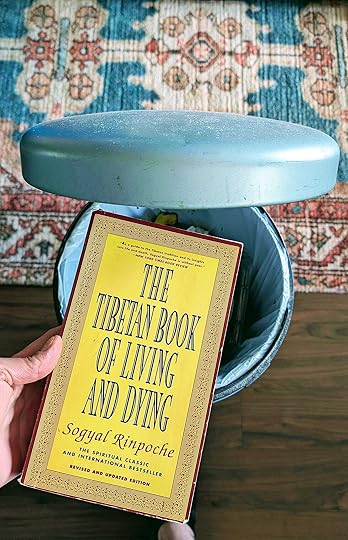 Master Soggy provided me my first failed foray into formal meditation.
Master Soggy provided me my first failed foray into formal meditation. Or—I might add—be like an eye staring at its own floaters.
Some afternoons the best you could do, less depressing than ingesting another hour of Disney Channel laugh track, was to cable surf south, away from those waves of toxic optimism, down to Maury, Jerry Springer, or Sally Jesse and watch your corneal cobwebs curl around the room, and wonder, as you listened to the eternal hum and bleep of the world—BLEEP! BLEEP you! You BLEEPing bastard! BLEEP sucker!!!—a world upon whose shores you found yourself so freshly thrown…
Who am I?
What am I?
Where am I?
…the eyes but two soggy non-grasping globes glinting out from the back of the living room as the broccoli started steaming, the microwave buttons beeping, the TV softly BLEEPING… And before it always the Flying Guy, my favorite floater, the one I always looked for first, a dirty little figure woven from the clear wicker of mosquito wings, his transparent twist ties twirling over the paternity test results, twitching as the teen mothers tore at their hair, flying over the airborne chairs that followed the polygraph results, the loud cheers of the makeover reveals, drifting over the shoulder of Darren, who wanted a drama free relationship, or Steve, so desperate he’d marry a horse, and Bob, who didn’t trust Regina. That’s why he watched her shower. I remember Kevin, too, a rebellious teen who went from gothic freak to gorgeous and chic. And Chiquanna, 15, who admitted to trading sex for a lobster buffet dinner. Brinkly, 17, attacked by the ants that came out of a flower.
 Consciousness Without Identity
Consciousness Without IdentityAnd Chad, 27—who could ever forget poor Chad?—a sobbing dwarf who fled the stage while his lover locked mouths with another man, a fat biker, and Jerry Springer standing by acting scandalized, mumbling some cliché about the heart’s caprice as the audience cackled, others cringing as the kissing continued audibly onstage, everything set for commercial break, a few important words from our sponsors until Chad bounced back brandishing a baseball bat and started swinging for the fences, every one of his homeruns fanning the Flying Guy higher and higher until he eventually floated out of frame and the daycare lady yelled my name.
“Barret!”
Yes, there really was so much beauty in the world. Sometimes you just couldn’t bear it.
“Why are you watching such… trash!?”
But I couldn’t tell the daycare lady the truth. You simply couldn’t swallow that many bags without coming to a similar conclusion. I was trash.
And yet being trash had certain advantages, as Brinkley, Chiquanna, and Kevin could no doubt attest. People tended to look past you if you weren’t pestering anyone, paid you no more mind on a warm laissez-faire day than the broken lever on their La-Z-Boy. And reclining amidst its commodious neglect, intoning the mind’s mantras, it was possible not only to trade sex for a lobster buffet, but also to train your eye on its own weird water spiders and slowly drift away… elsewhere, into a kind of ecstasy… a place where the sad sack of self somehow ceased to exist, had proven itself more disposable than any SC Johnson Ziploc, and all the pain and worry and plastic it carried, with nothing more to protect it, dissolved wholesale suddenly, like blue pigment in that warm fluid boundlessness in which all things abide, suspended and floating, including the BLEEPing Flying Guy.
Who am I?
What am I?
Where am I?
Dumpster Fires is beacon of light in a world of trash and sorrow. To receive new posts and support my work, consider becoming a free or paid subscriber.
May 7, 2025
Full Metal Book Jacket - Documentary Footage
“Writing is about discovering things hitherto unseen. Otherwise there’s no point to the process.” —W.G. Sebald
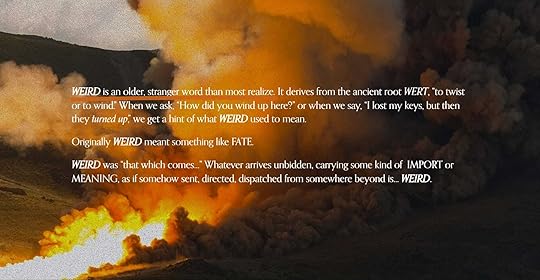
Weird is an older, stranger word than most realize. It derives from the ancient root wert, “to twist or to wind.” When we ask, “How did you wind up here?” or when we say, “I lost my keys, but then they turned up,” we get a hint of what WEIRD used to mean. Originally weird meant something like fate. Weird was “that which comes…” Whatever arrives unbidden, carrying some kind of import or meaning, as if somehow sent, directed, dispatched from somewhere beyond is… weird.
Or so I claim at the start of the above mini-doc produced by Nick Lacy that captures the magic and misery of my book release party at Angel City Brewery last month. Between this brewery presentation, and a few other speaking engagements and podcasts, I seem to have irrevocably committed my art and soul to word weird. But if you’ve been following me or read any of my series “The Heights of Weird,” you might not be surprised.
Many thanks to Nick Lacy for producing the above short film, Brandon Lien & Brandon Tran for shooting and editing, and Anton Lieberman for loaning the Joshua Tree video art which you can see on loop at Autry Museum of the West in Los Angeles. Thank you as well to Jessica Jelley and Angel City Brewery, and Christina Catania at Burro Social Co.
After this release party, YUCK has had a pretty fun run:
YUCK has been featured on local radio in Joshua Tree at Z107.7 FM.
For the past month YUCK has hovered at or just below #1 Best Seller slot in Amazon’s “Desert Ecosystems” (Amazon’s most competitive category).
I was honored to be featured on ’s phenomenal desert conservation podcast 90 Miles From Needles.
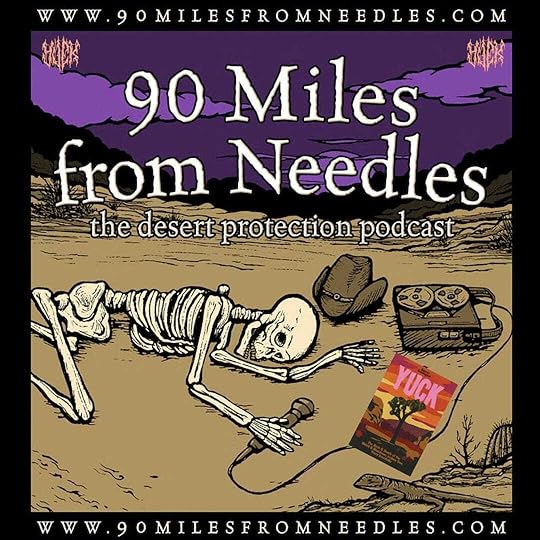 LISTEN HERE
LISTEN HEREI read and did an interview with Space Cowboy Books in Joshua Tree, CA.
I read and did a Q&A in Twentynine Palms.
More interviews/content on my Instagram, too much to list.
Find YUCK at all the cool stops: The Station in Joshua Tree, Mojave Flea in Yucca Valley, Hi Desert Times in Twentynine Palms, and in Los Angeles at Skylight Books, The Last Bookstore and Book Soup.
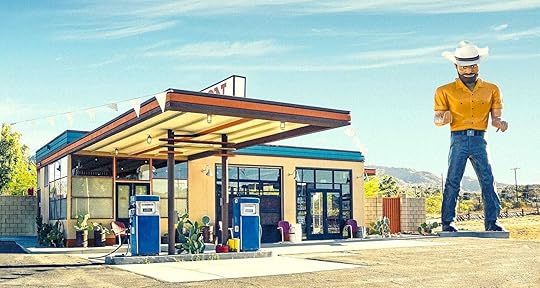 The Station, Joshua Tree
The Station, Joshua TreeTwo more podcast appearances booked in the next week and several requests in the works.
Readings being planned in San Diego and West Hollywood. A presentation of YUCK is also scheduled in Los Angeles at the Philosophical Research Society in Los Feliz on June 26th.
Thank you to everyone who has bought and read the book and/or listened to the Audiobook.
If you’ve enjoyed YUCK, please leave a review on Amazon right now !!!
Dumpster Fires is a beacon of light in a world of trash and sorrow. To receive new posts and support my work, consider becoming a free or paid subscriber.
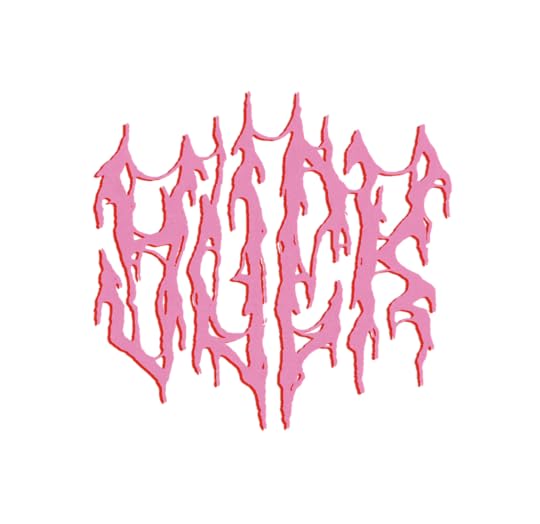
April 2, 2025
Cosmic Bard of the California Badlands
“Even the trees are in misery.” —Werner Herzog
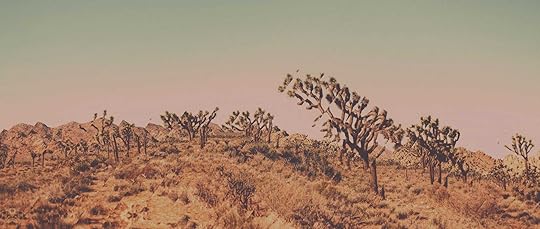
Scroll to the end for radio news, YUCK t-shirts & totes, and upcoming events.
I never would have written my new book YUCK, which came out last Wednesday, if I had not stumbled onto the brilliant forgotten work of Joseph Smeaton Chase, whose California Desert Trails (1919) is an unsung masterpiece of American literature and one of the greatest “Travel” books ever written.
YUCK is dedicated to this dead Englishman who captured the beauty and brutality of the Mojave and Colorado deserts in poetic brushstrokes still beaten by nobody in American letters—not even the late great masculine master of the desert west, Mr. Cormac McCarthy.
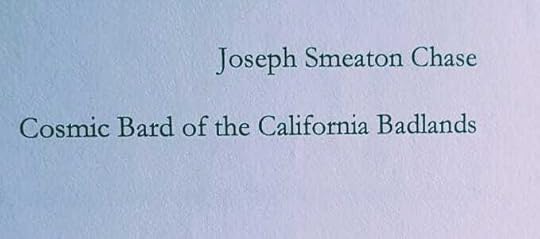
I’ve never spoken to or corresponded with any other living human who has read Joseph Smeaton Chase, and my knowledge of the abiding obscurity of his genius has long afforded me a secret pleasure.
How is it that one of the greatest books ever written about “Nature” or “Travel” is still totally unknown, out of print, impossible to find except in some shit edition printed off some guy’s computer in San Bernandino? It is an enigma analogous to that which I encountered over a decade ago with J.A. Baker, an author I wrote about at length back in September (“Pagan Vision for the Autumn Season”) and who rivals J.S. Chase as perhaps the most ecstatic, visionary, and underappreciated “Nature” writer of the 20th century.
How do artists of such daring vitality go on hidden? And when you’ve found them—should you respect their cultic slumber or set a blazing dumpster fire in the back alley to broadcast their brilliance?
I was tipped off to the works of J.S. Chase by an excellent and important essay by , host of 90 Miles from Needles: The Desert Protection Podcast. A quote from J.S. Chase, featured in Clarke’s essay, set the ominous tone for the wedding Christina and I planned for April 2020 in Joshua Tree, California—a connubial ritual that was ultimately canceled three times by Covid and later never consummated.
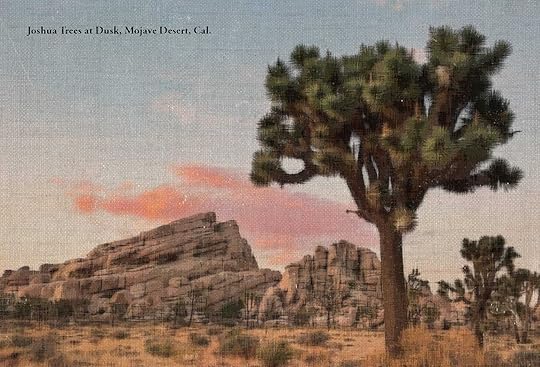
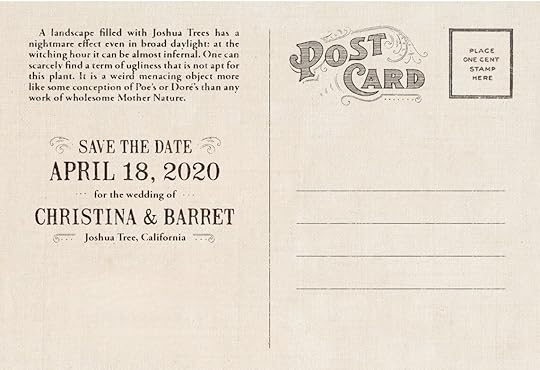 Our vintage wedding invite postcard with J.S. Chase quoted on rear
Our vintage wedding invite postcard with J.S. Chase quoted on rearYou can read briefly about this conjugal disaster and the backdrop that birthed YUCK in the book’s Preface… And if you must know, YUCK is also dedicated to the woman whose passion for the desert outstrips my own.
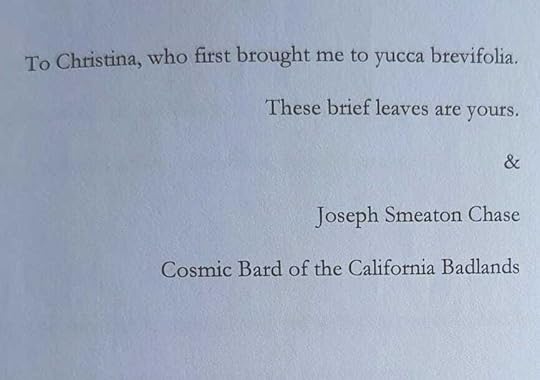
It was Christina who first brought me to Joshua Tree, and while much of YUCK concerns how blown up that town and park have become, I remain cheered by the enduring unpopularity of its greatest poet, Joseph Smeaton Chase. He is in himself a microcosm for the California desert, a vastness that remains on the whole ignored and unexplored, unknown and unimagined, dead and undreamt of to the hurrying swarm of humanity waiting in long air-conditioned lines to invade the National Park each Saturday.
And such obscurity gives me hope.
There is a tendency to assume we have unearthed all the good stuff, dissected and disenchanted this crowded corner of the continent, that every good mystery and mountain canyon must be mapped and cataloged, its ruins carted off, sorted and analyzed and posted online. It’s easy to fall into a habit of thinking that there is nothing new to discover and discuss except the next snafu barreling down the sewer-brown stream of our social media. But as I continue to find, whenever I dedicate my attention to the desert landscape, there is a wealth strangeness still sitting there.
And it was the abiding mystery that captured J.S. Chase, “the pale, grave face of the desert,” as he said, that “if once you look long upon it, takes you more subtly captive and keeps you enchained… as if you were bemused by the gaze of a sorceress, or had listened over long to some witching, monotonous strain; or had pondered too deeply on old legends of weirdry or parchments from tombs of strange, forgotten lands...” Chase goes on:
“I ask myself again, into what single impression does the desert render itself? …The answer must be, there is none. At every point the desert meets us with a negative. Like the Sphinx, there is no answer to its riddle. It is in the fascination of the unknowable, in the challenge of some old unbroken secret, that the charm of the desert consists. And the charm is undying, for the secret is—Secrecy.”
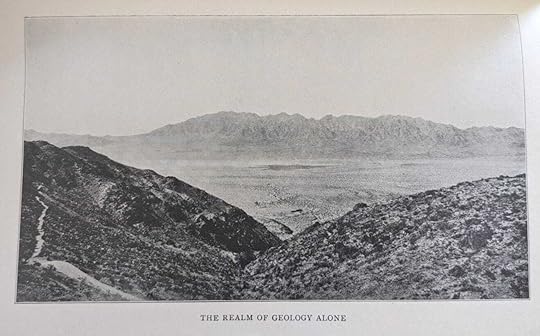 A photo by J.S. Chase from California Desert Trails, 1919.
A photo by J.S. Chase from California Desert Trails, 1919.Yes, the Mojave Desert is ripe with secrets. It is a realm not of geology alone. There is something else here, alive, biding its time... And if you stare and listen too long, it may hold you captive, keep you bemused, obsessed, stranded until you finish a first, a second, and soon, I hope, a third book.
As I said last week at the release party for YUCK, I don’t know how I keep discovering such weird shit in the desert, or why it keeps finding me.
But in either case, I have a relationship with the Mojave. We are intimate. Entangled in some way. But this acquaintance, as Chase wrote, “Certainty it is not love, in any degree, that one feels for the desert… whatever it is, there is something of haunting in it.”
And as Chase concludes, it “is a haunting that lasts for life.”
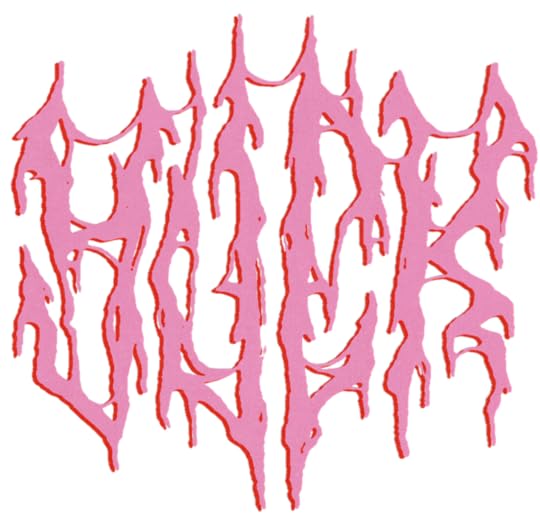 Purchase the book or audiobook—narrated by me—on Amazon or Audible today and write a review.
Purchase the book or audiobook—narrated by me—on Amazon or Audible today and write a review.Z107.7 FM, who “broadcast live from a vortex near Joshua Tree,” interviewed me on Monday. Look for that Friday. The radio segment on YUCK also mentions my reading and signing happening outside Joshua Tree at Hi Desert Times this Saturday, April 5th at 2:00 pm.
If you know anybody who’d be interested in discussing the strange, buried history of the Joshua Tree that YUCK uncovers, send them my way.
And finally, if you’re in a good mood and want to consume, I have some shirts and tote bags leftover from the book release party.
“Writing is about discovering things hitherto unseen. Otherwise there’s no point to the process.” —W.G. Sebald
Thinking of things seen and unseen… I mentioned Cormac McCarthy earlier and I’m reminded of the final note in YUCK—note #103—which occurs on the last page of the book, page 117:
103, We are waiting for you: have waited since eternity began: These spectacular lines are borrowed from the transcendent and vastly underappreciated visionary masterpiece frequently quoted throughout this text, a book that initiated much of this research in its passionate and disorienting depictions of the Joshua’s grotesquerie. What kind of author is crazy enough to claim that “A landscape filled with Joshua trees has a nightmare effect even in broad daylight: at the witching hour it can be almost infernal”? Even in broad daylight!? Joseph Smeaton Chase’s unrelenting California Desert Trails (1919) deserves a new edition from a reputable publisher with an inspired intro. I’m certain the book influenced many writers, even some of the best, particularly Cormac McCarthy. It is interesting to note that the latter’s Southwestern novels, despite the dark precision of their surrealistic prose painting, eschew any rendering of the desert’s most repulsive landscape prop, the Joshua Tree. The omissions is really quite weird. Yucca brevifolia is mentioned only once in an unremarkable phrase at the start of Blood Meridian. “All day they climbed through a highland park forested with joshua trees and rimmed about by bald granite peaks.”
How is it that in all the enviable, unfathomable cinematic montages and mind-blowing million-dollar landscape portraits Cormac McCarthy lofts across the 1,200+ pages of his western novels, he managed to mention the phrase “Joshua Tree” only once… and to do nothing with the image?
It makes me think of that impressive Vanity Fair essay that came out a few months ago—one of the biggest literary scoops in recent years—written by , wherein the author mentions, by way of McCarthy’s former lover, that McCarthy, author of All the Pretty Horses, never actually once rode a horse.
Apparently, he also never took a good look at a Joshua Tree.
I hope after reading YUCK you won’t ever look at a Joshua Tree the same.
Dumpster Fires is a beacon of light in a world of trash and sorrow. To receive new posts and support my work, consider becoming a free or paid subscriber.
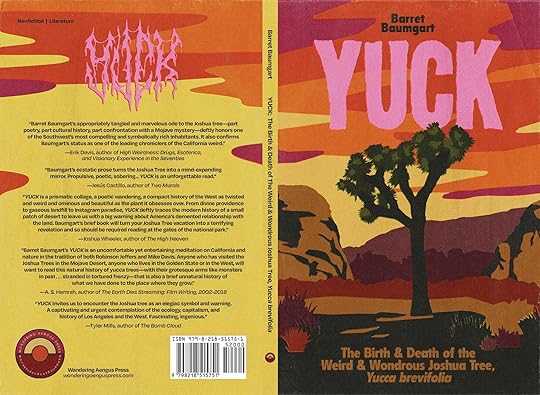
Dumpster Fires
@ https://dumpsterfires.substack.com/
Dumpster Fires is your definitive guide to the catastrophic homeless crisis unfolding outside certain windows in Los Angeles. It's also where a Follow on Substack
@ https://dumpsterfires.substack.com/
Dumpster Fires is your definitive guide to the catastrophic homeless crisis unfolding outside certain windows in Los Angeles. It's also where award-winning "weird" nonfiction writer Barret Baumgart cooks up new plagues of uncanny research exhumed across California's Mojave Desert and the wasteland of Los Angeles for the morose delectation of a limited but discerning literary readership. "This infected light saved my life!" -Rob ...more
- Barret Baumgart's profile
- 10 followers


